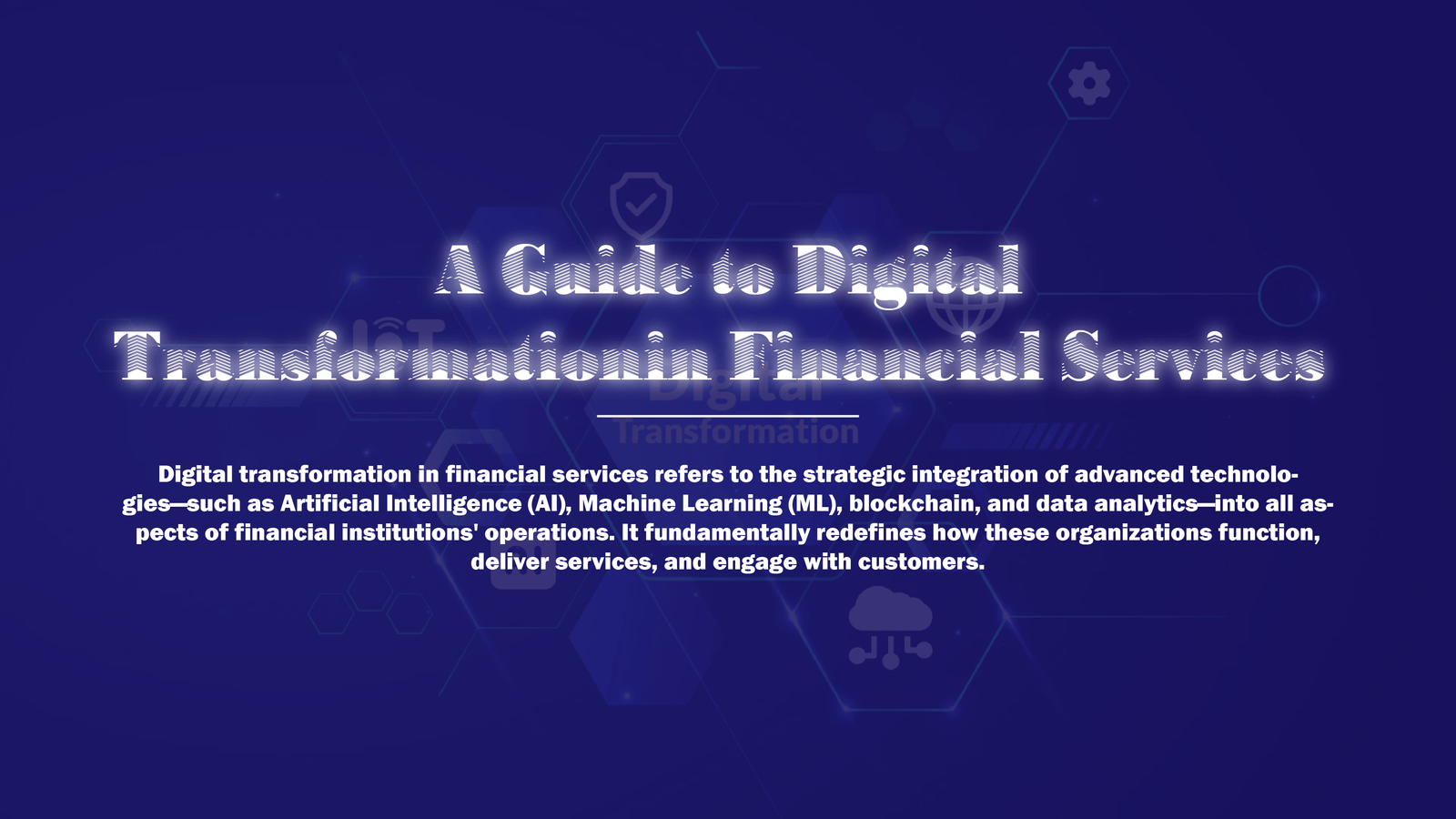October 7, 2024 | by Muaz ibn M.

Digital transformation in financial services refers to the strategic integration of advanced technologies—such as Artificial Intelligence (AI), Machine Learning (ML), blockchain, and data analytics—into all aspects of financial institutions’ operations. It fundamentally redefines how these organizations function, deliver services, and engage with customers.
By leveraging these cutting-edge tools, financial institutions aim to enhance operational efficiency, boost productivity, and provide a seamless, personalized customer experience. In addition, digital transformation empowers employees with better tools and data-driven insights, fostering a culture of innovation and agility in a highly competitive industry. Ultimately, it’s about creating more responsive, resilient, and forward-thinking financial institutions to meet the evolving demands of today’s digital-first consumers.
Digital transformation in financial services represents a fundamental shift in how institutions leverage technology to deliver value to customers, enhance operational efficiency, and ensure long-term competitiveness. This transformation involves integrating modern technologies such as artificial intelligence (AI), blockchain, cloud computing, and big data analytics into financial operations.
Leadership plays a crucial role in driving digital transformation. Successful transformation requires a clear vision, strategic planning, and a culture that embraces change. Leaders must invest in technology and talent to foster innovation.
By integrating these technologies and strategies, financial institutions can not only stay competitive but also provide superior value to their customers. The journey of digital transformation is ongoing, with continuous advancements shaping the future of financial services.

For decades, financial institutions have relied on traditional, brick-and-mortar banking methods, often characterized by legacy systems that hinder innovation. Traditional banking refers to services provided by banks that have been the backbone of financial systems for centuries, including savings accounts, checking accounts, loans, and more. These banks have physical branches, a network of ATMs, and a rich history that dates back decades or even centuries.
Outdated Systems: Outdated systems are expensive to maintain, lack flexibility, and pose a significant challenge to scalability. For example, many banks still rely on COBOL-based systems, which are costly to update and integrate with modern technologies.
Competition from Fintech: Digital-first competitors, such as Chime and Upgrade, offer innovative financial products and services that attract tech-savvy customers. These fintech companies leverage advanced technologies to provide seamless, user-friendly experiences, putting pressure on traditional banks to innovate.
Evolving Consumer Behaviors: Today’s consumers expect real-time, personalized services. Mobile banking apps, AI-driven customer service chatbots, and personalized financial advice are becoming standard expectations. For instance, HSBC uses AI to provide tailored financial advice, enhancing customer satisfaction.
Regulatory Pressures: Compliance and regulatory pressures have escalated, demanding more transparent, secure, and efficient processes. Technologies like blockchain can enhance transparency and security, making compliance more efficient. For example, JP Morgan’s COiN platform uses AI to review legal documents, significantly cutting down the time required.
Given these challenges, the need for digital transformation in financial services is more pressing than ever. Financial institutions must innovate and adapt to stay competitive. This involves integrating modern technologies such as artificial intelligence (AI), blockchain, cloud computing, and big data analytics into their operations.
By embracing digital transformation, financial institutions can not only overcome the challenges posed by outdated systems and fintech competition but also provide superior value to their customers.

Advancements such as Artificial Intelligence (AI), Machine Learning (ML), Blockchain, and Data Analytics are rapidly transforming financial services, giving institutions new ways to streamline processes, improve customer engagement, and ensure security. Let’s break down each of these technologies with more specific examples to illustrate their profound impact on the industry:
Today’s consumers expect seamless, personalized experiences when interacting with financial institutions. Convenience, speed, and security are non-negotiable. Digital transformation allows banks and financial institutions to meet these expectations by providing services that are accessible anytime, anywhere. Here are examples that illustrate this shift:
Digital transformation allows financial institutions to anticipate and respond to changing consumer needs effectively. Those that fail to adapt risk being left behind in a market where customer loyalty is increasingly driven by convenience, personalization, and speed.
As regulations become more stringent, institutions are forced to adopt technologies that ensure compliance and security. Regulatory technology (RegTech), another subset of digital transformation, leverages AI and Blockchain to streamline regulatory processes, reduce compliance costs, and mitigate risk, all while ensuring institutions remain within legal frameworks.
AI and ML are playing a pivotal role in automating a wide array of financial services, from risk management to customer service. For example, AI-powered chatbots are increasingly being used to assist customers with account inquiries, loan applications, and more. Additionally, AI models can analyze vast amounts of data to predict customer behavior, optimize pricing strategies, and identify fraud patterns in real-time.
Blockchain is transforming financial services by offering enhanced security, efficiency, and transparency. This decentralized ledger system can process transactions more securely, reducing the need for intermediaries, which in turn lowers costs. Blockchain technology also enables smart contracts, which can automate payments and settlements, further driving efficiency in back-office operations.
Cloud computing offers financial institutions scalability, cost-efficiency, and enhanced data management capabilities. By leveraging cloud platforms, banks and financial service providers can analyze vast amounts of customer data, providing insights that drive personalization and improve customer service. Data analytics allows for predictive insights, fraud detection, and customer segmentation, all of which are critical to the success of digital transformation.
Digital transformation in financial services has revolutionized the way institutions engage with their customers. With the integration of AI, data analytics, and mobile platforms, banks can now offer hyper-personalized services tailored to individual needs.
Examples:
The rise of mobile banking and fintech solutions has significantly increased the accessibility of financial services. Customers can now manage their accounts, apply for loans, or transfer money through mobile apps and online portals, reducing the need for physical branch visits.
Examples:
Omni-channel services allow customers to access services across multiple touchpoints—whether it’s through mobile apps, chatbots, or in-branch interactions. This seamless integration of channels improves customer satisfaction and creates a unified experience, solidifying the institution’s role as a customer-first organization.
Examples:
By leveraging these technologies and innovations, financial institutions can significantly enhance the customer experience, making banking more personalized, accessible, and customer-centric.
By automating back-office processes such as loan approvals, data entry, and account management, financial institutions are achieving higher operational efficiency. Automation tools, like robotic process automation (RPA), are being widely implemented to minimize manual tasks, reduce errors, and lower operational costs.
A notable example of successful digital transformation is JPMorgan Chase’s use of AI to review legal documents. The system, known as COIN, has drastically reduced the time spent on this task, saving the company both time and resources. Similarly, Banco Bilbao Vizcaya Argentaria (BBVA) has adopted digital technologies to streamline processes, resulting in a 19% reduction in operating expenses.
Digital transformation introduces new security risks, including vulnerabilities in cloud infrastructures and mobile banking platforms. Cyber-attacks, such as phishing, data breaches, and ransomware, are on the rise, making it critical for institutions to invest in robust cybersecurity measures.
Institutions must adopt comprehensive security strategies, including encryption, multi-factor authentication, and continuous monitoring of systems. Leveraging AI and machine learning for real-time threat detection can also minimize the impact of cyber threats. Best practices in the industry include partnerships with cybersecurity firms and the use of advanced threat intelligence tools.
Leadership plays a crucial role in ensuring a smooth digital transformation. Leaders must establish a clear vision and roadmap that outlines the strategic goals of digital initiatives. They should foster a culture of innovation and encourage collaboration across departments to achieve long-term success.
Examples:
To ensure the workforce is equipped for the digital age, leaders must invest in employee training and development programs. Upskilling teams on new technologies such as AI, data analytics, and blockchain will be essential for seamless integration and maximization of the benefits of digital transformation.
Examples:
By setting a clear vision and investing in training and upskilling, leaders can drive successful digital transformations that position their organizations for long-term success.
Decentralized Finance (DeFi) is set to disrupt the traditional financial ecosystem by offering open, decentralized alternatives to conventional banking. Built on blockchain technology, DeFi enables peer-to-peer transactions without intermediaries, which could significantly impact how financial services are delivered.
AI-driven decision-making is gaining traction, with AI models expected to handle everything from credit approvals to investment strategies. These models will enhance the speed, accuracy, and personalization of financial decisions, pushing institutions towards fully automated services.
In the coming decade, we’ll likely see the rise of quantum computing, which could revolutionize data processing speeds, and augmented reality (AR), which could transform customer interactions within digital banking platforms.
Digital transformation in financial services is no longer an option; it’s a necessity. As technological advancements like AI, ML, blockchain, and data analytics continue to evolve, they are fundamentally reshaping how financial institutions operate and engage with customers. These innovations are streamlining processes, enhancing security, and delivering personalized, convenient services that modern consumers demand. In a rapidly changing environment, institutions that embrace digital transformation will gain a competitive edge, drive operational efficiency, and improve customer satisfaction.
However, the journey doesn’t end with technology. Leadership plays a pivotal role in ensuring that these changes are embraced at every level of the organization, fostering a culture of innovation and continuous learning. As the industry continues to adapt to emerging trends like decentralized finance (DeFi) and AI-driven decision-making, financial institutions must remain agile, future-proof their operations, and invest in the digital infrastructure necessary to stay ahead.
Ultimately, the institutions that prioritize digital transformation today will be the ones best equipped to thrive in tomorrow’s financial landscape. Now is the time to innovate, adapt, and lead the charge toward a more secure, efficient, and customer-centric future in financial services.
Digital transformation in financial services involves integrating advanced technologies like AI, ML, blockchain, and data analytics into banking and financial institutions. This transformation enhances efficiency, improves customer experiences, and enables better decision-making.
Digital transformation is crucial for financial institutions to remain competitive, meet changing customer expectations, increase operational efficiency, and adapt to regulatory requirements. It also helps improve security and reduce costs through automation.
AI helps financial institutions automate processes like fraud detection, customer support, and credit scoring. It also enables personalized banking experiences by analyzing customer data to provide tailored services and recommendations.
Blockchain enhances transaction security, transparency, and efficiency in financial services. It enables faster cross-border payments, secure data storage, and the use of smart contracts, reducing the need for intermediaries and increasing trust.
Consumers now demand convenience, personalization, and speed in their banking experiences. Mobile banking apps, digital wallets, and omni-channel services are driving financial institutions to adopt digital technologies to meet these demands.
Financial institutions face challenges like integrating new technologies with legacy systems, ensuring cybersecurity, maintaining regulatory compliance, and upskilling employees to handle digital tools and processes effectively.
Future trends include the rise of decentralized finance (DeFi), increased use of AI-driven decision-making, the expansion of blockchain applications, and the integration of more personalized, data-driven financial services to enhance customer engagement.
View all